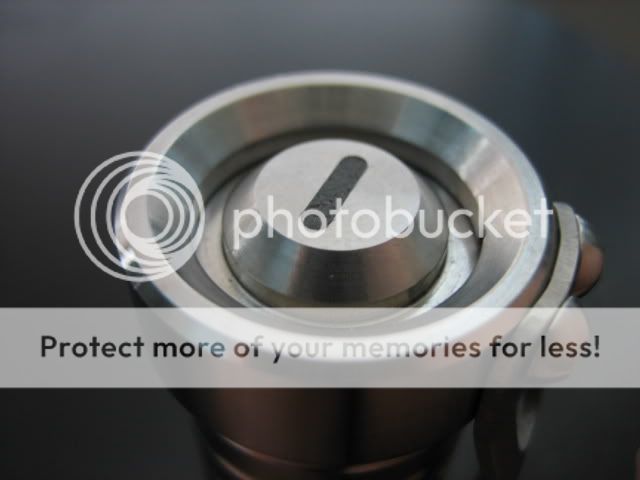Roccomo
Enlightened
- Joined
- Jul 3, 2006
- Messages
- 201
I dropped my LS20 hard onto the tile floor in my bathroom two nights ago. Total damages were: one nicely chipped tile, a mild 'push' on the lower side of the tail section with tiny 'roll' of Ti towards the bottom bevel and a roughly indented 'grind' up at the bezel end with the Ti scuffed to its natural dark gray color. I don't have a pic of the damages to the light because I didn't notice them till lunchtime at work yesterday.
So, I looked around my desk trying to figure out what I could use to fix the two dings. I work in an office so there are no tools available and certainly no sandpaper or polish. I grabbed a business card. Its texture was slightly rougher than paper. Figuring that I didn't have anything to lose I spent about 20 minutes 'sanding' the 'push and roll' on the tail section with the back of that card. It completely removed the problem area without leaving a polished, shined or differently textured spot in its place. I couldn't have planned a better result:thumbsup:
With that great success and experience as a Ti fixer ;-} I could tell that the scuff up at the bezel was going to require something a bit more gritty than my business card. This damage was more like you'd see when dropping something on concrete. An almost black area with a lot of tiny deep dents/scratches very close together, about 2mm by 3 mm. I looked around my desk again and grabbed a legal pad. The cardboard back seemed to have the required roughness so, holding the light like a pencil pressed to it, I started working on it. Little by little the black rough area started to be replaced by smooth Ti. By the end of my lunch it was getting to be a lot harder to tell where the damage was. End result is that my LS20 looks as good as when Don first shipped it to me. Added bonus: The Ti fixed up nicely without displaying two high polish spots that, to me, would have been an eyesore equal to the original damage.
On a totally unrelated note. I removed the H2 vial from the piston and filled the routed area with FastSteel. I considered filling the route with the same epoxy Don uses but this stuff was under $5.00. It's been a month and though I wasn't sure it would work at all it seems to be ok and I like this better than the H2 vial:

So, I looked around my desk trying to figure out what I could use to fix the two dings. I work in an office so there are no tools available and certainly no sandpaper or polish. I grabbed a business card. Its texture was slightly rougher than paper. Figuring that I didn't have anything to lose I spent about 20 minutes 'sanding' the 'push and roll' on the tail section with the back of that card. It completely removed the problem area without leaving a polished, shined or differently textured spot in its place. I couldn't have planned a better result:thumbsup:
With that great success and experience as a Ti fixer ;-} I could tell that the scuff up at the bezel was going to require something a bit more gritty than my business card. This damage was more like you'd see when dropping something on concrete. An almost black area with a lot of tiny deep dents/scratches very close together, about 2mm by 3 mm. I looked around my desk again and grabbed a legal pad. The cardboard back seemed to have the required roughness so, holding the light like a pencil pressed to it, I started working on it. Little by little the black rough area started to be replaced by smooth Ti. By the end of my lunch it was getting to be a lot harder to tell where the damage was. End result is that my LS20 looks as good as when Don first shipped it to me. Added bonus: The Ti fixed up nicely without displaying two high polish spots that, to me, would have been an eyesore equal to the original damage.
On a totally unrelated note. I removed the H2 vial from the piston and filled the routed area with FastSteel. I considered filling the route with the same epoxy Don uses but this stuff was under $5.00. It's been a month and though I wasn't sure it would work at all it seems to be ok and I like this better than the H2 vial:





